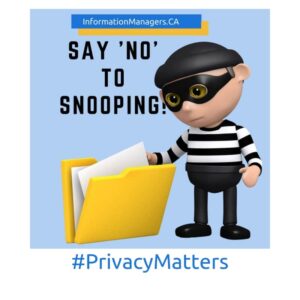
Build a Strong Privacy Management Program for Your Clinic With These 5 Critical Modules
Struggling to Learn Your Role As A Privacy Officer?
In many small healthcare practices, the privacy officer is also the clinic manager, healthcare provider, IT technician, or business owner. It’s no surprise that new privacy officers feel overwhelmed trying to balance competing responsibilities.
Without a clear plan, you may find that you
- Panic when a patient asks for their information for access or correction.
- Scramble when new employees and healthcare providers join your clinic . . .and suddenly realize that you never got around to providing privacy and cybersecurity awareness training.
- Hope that your practice will not be tapped on the shoulder for a practice review by your college or the OIPC.
- Ignore privacy breach and hope no one else notices.
- Avoid difficult decisions with your owners / staff who insist on doing things their way – even when it is not privacy compliant.
- Never get ‘review privacy impact assessment’ and ‘review privacy policies and procedures’ off of your to-do list.
- Avoid discussing privacy and security with your EMR and computer networks managed service providers because you are unsure of what questions to ask and what types of answers you should receive.
If you don’t have a written privacy management program and action plan, you are missing the systems that prevent small issues from becoming privacy and security incidents.
The good news? Organizations with an active privacy officer and privacy management program are less likely to experience breaches and report better staff engagement and patient trust.
Privacy Is Good For Business
Strong privacy practices aren’t just about legal compliance. Policies, procedures, and systems improve communication, reduce risk, and support better decision-making.
A practical privacy management program creates accountability for the collection, use, and disclosure of health information, while demonstrating compliance to regulators and professional colleges.
Based on my experience, the five critical modules of a privacy management program are:
- Know Your Obligations
- Train
- Privacy Breach Management
- Document your Privacy Management Program
- Access and Disclosure
Module 1—Know your Obligations
Accountability starts with your healthcare provider(s)—also known as “custodians.” They are legally responsible for the privacy, confidentiality, and security of personal health information (PHI).
Custodians can delegate day-to-day tasks to a privacy officer, often the clinic or practice manager in smaller settings. Business owners also have obligations for employee and customer information. Together, the healthcare provider, business owner, and privacy officer form a trifecta of authority responsible for privacy compliance.
Knowing your obligations means:
- Establishing clear roles and accountability
- Identifying all types of personal and health information in your practice
- Understanding how privacy legislation applies to your operations
Training for custodians and privacy officers is often required to build confidence and competence in these responsibilities.
Module 2 – Training
Privacy training is essential and must be consistent across your organization. Every staff member—new and experienced—should complete privacy awareness and cybersecurity training, and you should document attendance.
Effective training includes both formal and informal opportunities:
- Formal: orientation programs, annual refreshers, and documented privacy awareness training
- Informal: short reminders in staff meetings, activities tied to events like Data Privacy Day or Cybersecurity Awareness Month
Don’t overlook staff moving into new roles—promotions are an ideal time for targeted training about new responsibilities, such as authorizing users or supervising others.
Module 3 – Privacy Breach Management Plan
Every practice needs a written privacy breach management procedure. The privacy officer should ensure staff know how to recognize and report a breach, and custodians must be notified promptly.
Your plan should cover:
- How to contain and investigate suspected breaches
- Sanctions for non-compliance
- Notification to patients and regulators when required
The privacy officer will manage mandatory privacy breach notification requirements under the health privacy legislation like the Alberta Health Information Act (HIA), Ontario Personal Health and Information Protection Act (PHIPA) and the Personal Information Protection of Electronic Documents Act (PIPEDA) and other province’s legislation.
Module 4 – Document: The Backbone of Privacy Compliance
Privacy training is essential and must be consistent across your organization. Every staff member—new and experienced—should complete privacy awareness and cybersecurity training, and you should document attendance.
Effective training includes both formal and informal opportunities:
- Formal: orientation programs, annual refreshers, and documented privacy awareness training
- Informal: short reminders in staff meetings, activities tied to events like Data Privacy Day or Cybersecurity Awareness Month
Don’t overlook staff moving into new roles—promotions are an ideal time for targeted training about new responsibilities, such as authorizing users or supervising others.
Module 5 – Access and Disclosure: Ensuring Patient Rights
Patients and employees have the right to access and correct their information. Release of information (ROI) policies and procedures are essential.
Your ROI plan should:
- Define clear steps for handling requests
- Train staff on how to respond appropriately
- Align with legislation and college standards of practice
Doing this well helps you avoid complaints and breaches, improves efficiency, and strengthens patient trust.
Bringing It All Together
Being a privacy officer doesn’t have to feel overwhelming. With a structured privacy management program built on these five modules, you’ll have the systems to protect patients, support your staff, and strengthen your business.
If you’re a privacy officer in a healthcare practice and want practical strategies you can apply right away, join the upcoming Practical Privacy Officer Strategies training.
Training starts October 9, 2025
Register here https://informationmanagers.ca/ppo
Not sure if this is for you?
Send me an email and ask me! I’m happy to mentor you and help you assess your practice management and privacy compliance priorities.










